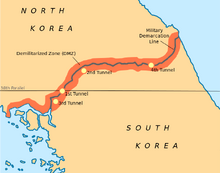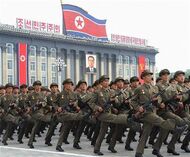| Second Korean War (Total Reunification) | |||||||
|---|---|---|---|---|---|---|---|
| Part of Korean conflict, Division of Korea | |||||||
| 280px 280px | |||||||
| |||||||
| Belligerents | |||||||
| Allied Coalition
Major Players Supported by: |
Supported by: | ||||||
The Korean Conflict of 2018, also known as the Second Korean War, began when North Korea invaded South Korea for the second time since the end of the 1950-1953 Korean War, with aims to unite the entire Korean Peninsula under the Juche banner. The war was fought primarily with the United States, South Korea, and Japan. Other nations intervened on behalf of South Korea, mostly RIMPAC members, ANZUS treaty allies and other allies of the United States; namely Australia, New Zealand, the United Kingdom, France, the Philippines, Thailand, Brunei, Malaysia, Indonesia, India, Vietnam, Taiwan, Singapore, Mexico, Colombia, and Chile against the Korean People's Army of North Korea. Notably, this is the first time RIMPAC members from Latin America participated with a conflict with their American and Pacific-Asian allies.
For the major players of the conflict and the forces committed, click here:
Belligerents of the Second Korean War (Total Reunification)
Background[]

Map of the Korean Peninsula before the war.
The Korean peninsula was occupied by the Empire of Japan in 1910 following their victory over the Russian Empire during the Russo-Japanese War. The Japanese rule was harsh, but it did help and modernize the peninsula. The Second Sino-Japanese War broke out in 1937, following Japan's invasion of Manchuria and the Rape of Nanking. The Japanese also fought a border war with the Soviets in Khalakin Gol in Mongolia. In this battles, it is known that the Imperial Japanese Army forcibly conscripted some Koreans to fight in their imperial ambitions. Despite this, some Koreans resisted the Japanese rule. Such were inspired by the anti-imperalist, Marxist-Leninist movements in Europe. One of them was Kim-il Sung, a communist and an anti-Japanese resistance fighter. These resistance fighters fought the Japanese long enough before the Soviets declared war on Japan on August 9, 1945 (the same day as the United States dropped a second atomic bomb in Nagasaki). The Soviets invaded Manchukuo (Manchuria) and the Korean peninsula, subsequently liberating them from the Japanese. The Empire of Japan surrendered unconditionally to the Allied powers on August 15, 1945, also known as Victory in Japan (VJ Day). Japan formally surrendered on September 2, 1945. In accordance with the Tehran conference, the Soviets occupied the northern half of the peninsula while the United States occupied the southern half. The border was at the 38th parallel. As time went by, the Soviets would spread communism to the northern peninsula, while the South was influenced with the ideals of capitalism and democracy. Elections were held in 1948, with the establishment of the Republic of Korea (South Korea) and the Democratic People's Republic of Korea (North Korea). Dispute came in what state would rule the peninsula, whether it should be under democracy or communism. A series of border conflicts erupted during these times. The United States, by 1949, also began withdrawing troops from the peninsula, while the ones that stayed remained lax and overconfident that war would not break out between the two.
This proved wrong, as on June 25, 1950, North Korea invaded South Korea with the intent of unifying the Korean peninsula under communist rule. Both the U.S. and South Korean forces were caught off guard with the situation and suffered defeat after defeat. This was mainly because the U.S. troops remained laxed throughout their stay; their South Korean counterparts were not battle tested and were afraid of the sight of combat. The Korean People's Army, or the army of North Korea, were already battle hardened and indoctrinated with the ideologies of Juche and communism. The United States then sent reinforcements from nearby Japan, however, this was not enough to slow the North Korean advance. The last stand was in Pusan, where the retreating South Korean and U.S. troops would holdout long enough for other United Nations forces to reinforce them. On September 18, 1950, the United Nations mounted an amphibious assault on the city of Inchon, pushing the Korean People's Army past the 38th parallel. Later that month, the UN Forces captured Pyongyang and were now close to the Chinese border. This concerned Chairman Mao Zedong, who did not want any American influence on the border of Korea and China. The Chinese warned the UN to stay away from the Yalu River, to no avail. By October 1950, the People's Volunteer Army crossed the Yalu River and surprised the United Nations with large human wave attacks. The UN was pushed back to the 38th parallel and Seoul was recaptured by the communist forces. Seoul was eventually retaken, and the Korean War became a stalemate until an armistice was signed in 1953.

Map of the Korean Demilitarized Zone (DMZ). 1953-2018.
Since no peace treaty was signed, both North and South Korea were technically at a state of war. In 1969, a short conflict erupted on the DMZ, which is known Korean DMZ conflict. Some historians consider it as the "Second Korean War." Several border clashes, terrorist attacks, and kidnapping incidents occurred throughout the 70s-90s, During the 2010s decade, the peninsula would experience the highest tensions with both of the nations. On March 26, 2010, the RKOS Cheonan sunk after being torpedoed by a North Korea submarine. The South retaliated by holding joint exercises with the United States Navy. On the same year, on November 23, North Korea shelled Yeongpeong Island.
Planning Phase for the Invasion[]

Korean People's Army military parade in Pyongyang. February 2018.
Majority of the Korean People's Army were mobilized for the upcoming war. In the days leading to the war, military parades were commonly seen in Pyongyang. Kim Jung-un was commonly seen in public making nationalistic speeches. North Korea fired missiles into the Sea of Japan, eliciting a response from the United States, South Korea, and Japan. Because of the military parades and massive mobilizations of the KPA, U.S. Forces in South Korea and the entire Pacific Command was put on high alert. The CIA analysts predicted that the North would attack somewhere on March-April 2018, during the EXERCISE FOAL Eagle, a joint U.S.-South Korean military exercise. To Kim Jung-un, he was pleased seeing this as he wanted to drown the "imperialists" and the "capitalists" in the "might of the Korean People's Army." However, he would catch them off-guard. Before the war, he already inserted several North Korean sleeper agents in cities across South Korea and Japan. These sleeper agents would conduct surprise terrorists attacks (stabbings, shootings, bombings, car bombs, etc) to bring shock to the populace. Once this happens, the KPA would sweep up across the DMZ and finally attempt to unify the Korean Peninsula under the Juche regime.

